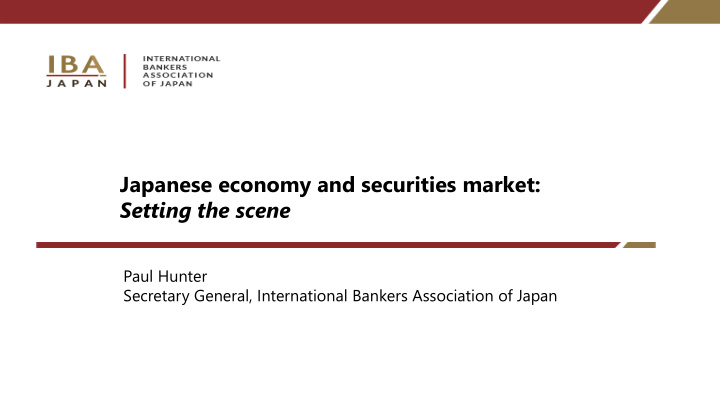



Japanese economy and securities market: Setting the scene Paul Hunter Secretary General, International Bankers Association of Japan
The Background Third largest global economy in the world. The major developed market in Asia. Well placed to do business with new and expanding markets in the region (Japan is an important source of capital to Asia). It does not do restrictions: there are no current account, capital account, exchange rate controls unlike some other Asian countries. A sound and predictable legal and business environment. An aging society with population size predicted to fall substantially. Dramatic changes in the energy mix post the ‘triple disaster’. The U.S. is Japan’s largest trading partner followed by China and the EU (20%, 17.5% and 10.6% respectively). 2
Japanese business environment 52 Fortune 500 companies in 2016 are Japanese – ranking third. 11% of firms in Fortune 2000 are Japanese. Major globally recognized companies across sectors e.g. car manufacturing, electronics, heavy industry, renewables, transport, trading companies. Japan has the third highest global R&D spend. Japanese companies are cash rich active in the M&A market. In 2016, outbound M&A by Japanese firms continued to be strong; JPY 10.4 trillion (USD 90 billion). Recent activity includes Softbank buying ARM, Mizuho targeting RBS North American loan book, and Asahi buying SAB Miller. 3
The scale Remember there are some big numbers: Large pension funds JPY 360.2 trn ($ 3.2 trn, Sept 2016, BOJ), e.g. Government Pension Investment Fund with JPY132.8 trn ($ 1.17trn, Sept 2016) which is the world’s largest public pension fund. Japan has the largest accumulation of personal wealth in the world – amounting to JPY 1,752 trn ($ 15.5 trn, Sept 2016, BOJ). Government bond market (JPY929trn, Dec 2016, MOF). Size of stock market: TSE market capitalization (section 1) was JPY 566 trn ($ 5 trn), Feb 2017. 4
Abe administration Elected December 2012. His two back to back terms give him a rare bout of stability and the opportunity to effect some change. Levels of ambition: monetary policy, fiscal consolidation and structural reform. Major economic topics : TPP (getting to a position where it would be signatory although now thwarted) and progress on EU-Japan FTA – a variety reforms have been required across sectors. ‘Womanomics’: potential boost to GDP . Monetary policy developments: negative interest rates and targeting the yield curve and not the monetary base. Tax environment: corporate tax reduction (but probably more needed to be competitive) and ‘My Number’ (Tax payer id system) which is aimed at stopping tax evasion, but out of kilter on inheritance tax changes for foreign workers. Tokyo as financial centre: role of Governor Koike, the vision and environment to be profitable and building on macro advantages. Capital markets changes: JPX400, Stewardship and Corporate Governance Code, GPIF mandate reform – and their impacts. But the markets are clearly looking for more expansive and more timely changes. 5
Capital Markets Activity Boosted by Abenomics JPX Volume (JPY Bn) Nikkei 225 22,000 6,000 20,000 5,000 18,000 4,000 16,000 3,000 14,000 2,000 12,000 1,000 10,000 8,000 0 Source: Japan Exchange Group Nikkei 225 (Left-hand scale) Trading Volume (Right-hand scale) Daily average volume pre-Abenomics Daily average volume post-Abenomics 6
Recommend
More recommend